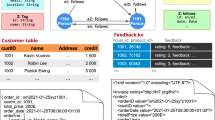Abstract
This paper describes a knowledge-based Web Service composition system, called SWIM, which is based on the Service Domain model. Service Domains are communities of related Web Services that are mediated by a single Web Service, called the Mediator Service, which functions as a proxy for them. When a requestor sends a message to the Mediator Service one or more of the related Web Services are selected to dispatch the message and the results returned are aggregated to a single answer to the requestor. Mediator Services can be further composed to more complex Mediator Services that combine several selection and aggregation algorithms among many heterogeneous web services. The system utilizes the X-DEVICE deductive XML rule language for defining complex algorithms for selecting registered web services, combining the results, and synchronizing the workflow of information among the combined web services in a declarative way. In the paper, we demonstrate the flexibility and expressibility of our approach for composing Web Services using several e-business examples, covering most of the workflow patterns found in a comprehensive workflow management system (van der Aalst et al., Distributed and Parallel Databases, vol. 14, no, 1, pp. 5–15, 2003).
Similar content being viewed by others
References
W. van der Aalst, “Don’t go with the flow: Web services composition standards exposed,” IEEE Intelligent Systems, vol. 18, no. 1, pp. 72–76, 2003.
W. van der Aalst, A. ter Hofstede, B. Kiepuszewski, and A. Barros, “Workflow patterns,” Distributed and Parallel Databases, vol. 14, no. 1, pp. 5–51, 2003.
A. Ankolekar et al., “DAML-S: Web service description for the semantic web,” in Proc. Int. Semantic Web Conf., LNCS 2342, Springer-Verlag, Berlin/Heidelberg, 2002, pp. 348–363.
A. Arkin et al., Web Service Choreography Interface (WSCI) 1.0, W3C Note, Aug. 2002. http://www.w3.org/TR/wsci/
A. Arkin, “Business Process Modelling Language (BPML),” BPMI Proposed Recommendation, Jan. 2003. http://www.bpmi.org
N. Bassiliades and I. Vlahavas, “Capturing RDF descriptive semantics in an object oriented knowledge base system,” in 12th Int. WWW Conf. (WWW2003), Budapest, Hungary, 2003.
N. Bassiliades and I. Vlahavas, “Processing production rules in DEVICE, an active knowledge base system,” Data and Knowledge Engineering, vol. 24, no. 2, pp. 117–155, 1997.
N. Bassiliades, I. Vlahavas, and A.K. Elmagarmid, “E-DEVICE: An extensible active knowledge base system with multiple rule type support,” IEEE Transactions on Knowledge and Data Engineering, vol. 12, no. 5, pp. 824–844, 2000.
N. Bassiliades, I. Vlahavas, and D. Sampson, “Using logic for querying XML data,” in Web-Powered Databases, D. Taniar and W. Rahayu (Eds.), Idea Group Publishing, 2003, pp. 1–35.
N. Bassiliades and I. Vlahavas, “A knowledge-based framework for building web service domains,” in 9th Panhellenic Conference in Informatics (PCI’2003), Thessaloniki, Greece, 21–23 November, pp. 331–345, 2003.
T. Bellwood et al., “UDDI version 3.0,” UDDI Spec Technical Committee Specification, July 2002. http://uddi.org/pubs/uddi-v3.00-published-20020719.htm
B. Benatallah, M. Dumas, and Z. Maamar, “Definition and execution of composite web services: The SELF-SERV project,” Bulletin of IEEE TC on Data Engineering, vol. 25, no. 4, pp. 47–52, 2002.
S. Boag et al., XQuery 1.0: An XML query language, W3C Working Draft, May 2003. http://www.w3.org/TR/xquery/
D. Box et al., Simple Object Access Protocol (SOAP) version 1.1, W3C Note, May 2003. http://www.w3.org/TR/SOAP/
D. Booth et al., Web Services Architecture, W3C Working Draft, Aug. 2003. http://www.w3.org/TR/ws-arch/
R. Chinnici et al., Web Services Description Language (WSDL) version 1.2, W3C Working Draft, June 2003. http://www.w3.org/TR/wsdl12/
S. Thatte (Ed.), Business Process Execution Language for Web Services (Version 1.1), May 2003. http://www-106.ibm.com/developerworks/webservices/library/ws-bpel
O. Diaz and A. Jaime, “EXACT: An extensible approach to active object-oriented databases,” VLDB Journal, vol. 6, no. 4, pp. 282–295, 1997.
P.M.D. Gray, K.G. Kulkarni, and N.W. Paton, Object-Oriented Databases, A Semantic Data Model Approach. Prentice Hall, 1992.
F. Leymann, “Web services flow language (WSFL 1.0),” IBM, May 2001. http://www-3.ibm.com/software/solutions/webservices/pdf/WSFL.pdf
F. Leymann, “Web services: Distributed applications without limits—An Outline,” in Proc. Database Systems for Business, Technology and Web (BTW 2003), G. Weikum, H. Schöning, and E. Rahm (Eds.), GI-Edition—Lecture Notes in Informatics (LNI), P-26, Bonner Köllen Verlag, 2003.
G. Piccinelli, Service Provision and Composition in Virtual Business Communities, Tech. Report HPL-1999-84, Hewlett-Packard, Palo Alto, CA, 1999. http://www.hplhp.com/techreports/1999/HPL-1999-84.html
Y.-S. Tan, B. Topol, V. Vellanki, and J. **ng, Implementing service Grids with the service domain toolkit, IBM Corporation, 2002.
S. Thatte, XLANG: Web Services for Business Process Design, Microsoft, Redmond, WA., 2001. http://www.gotdotnet.com/team/xml_wsspecs/xlang-c/default.htm
G. Tsoumakas, N. Bassiliades, I. Vlahavas, “A knowledge-based web information system for the federation of distributed classifiers,” Web Information Systems, D. Taniar and W. Rahayu (eds.), Idea-Group Publishing, Chapter 8, pp. 271–308, 2004.
J. Ullman, Principles of Database and Knowledge-Base Systems, Computer Science Press: Rockville, MD, 1989.
Author information
Authors and Affiliations
Corresponding authors
Rights and permissions
About this article
Cite this article
Bassiliades, N., Anagnostopoulos, D. & Vlahavas, I. Web Service Composition Using a Deductive XML Rule Language. Distrib Parallel Databases 17, 135–178 (2005). https://doi.org/10.1007/s10619-004-0087-z
Issue Date:
DOI: https://doi.org/10.1007/s10619-004-0087-z




